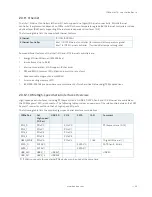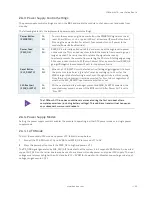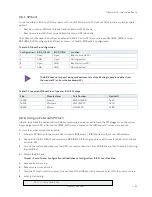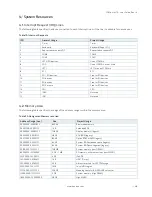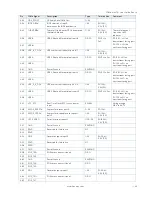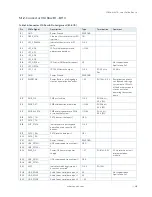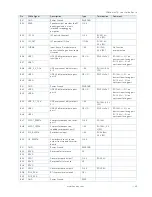
COMe-mAL10 – User Guide, Rev. 1.3
www.kontron.com
// 34
3.3.1.
SPI boot
It is not possible to flash to a SPI chip that is not the boot SPI Flash chip. To flash the SPI chip there are two possible
options:
Boot from internal SPI Flash chip and flash the internal SPI Flash chip
Boot from external SPI Flash chip and flash the external SPI Flash chip
The COMe-mAL10 supports boot from an external 16 MB, 3 V serial SPI Flash, where pin A34 (BIOS_DIS0#) and pin
B88 (BIOS_DIS1#) configure the SPI Flash as shown in Table 16: SPI Boot Pin Configuration.
Table 16: SPI Boot Pin Configuration
Configuration BIOS_DIS0#
BIOS_DIS1#
Function
1
Open
Open
Boot on module SPI
2
GND
Open
Not supported
3
Open
GND
Boot on carrier SPI
4
GND
GND
Not supported
The BIOS does not support being split between two chips. Booting takes place either from
the module SPI or from the baseboard SPI.
Table 17: Supported SPI Boot Flash Types for 8-SOIC Package
Size
Manufacturer
Part Number
Device ID
16MB
Maxim
MX25L12835F
0x20
16MB
Macronix
W25Q128FV
0x40
16MB
Micron
N25Q128A
0xBA
3.3.2.
Using an External SPI Flash
Initially, the EFI Shell is booted with an USB key containing the binary used to flash the SPI, plugged in on the system.
Depending on which SPI is flashed, the (BIOS_DIS1) jumper located on the COM Express® carrier must be used.
T
o flash the carrier or module Flash chip:
1.
Connect a SPI flash with the correct size (similar to BIOS binary (*.BIN) file size) to the carrier SPI interface.
2.
Open pin A34 (BIOS_DIS0#) and connect pin B88 (BIOS_DIS1#) to ground to enable the external SPI Flash to boot
on carrier
SPI.
3.
Turn on the system and make sure that USB is connected then start the uEFI BIOS setup. (See Chapter 6.1: Starting
the uEFI BIOS.)
4.
Disable the BIOS lock:
Chipset > South Cluster Configuration> Miscellaneous Configuration> BIOS Lock > Disabled
5.
Save and Exit the setup.
6.
Reboot system into EFI shell.
7.
From the EFI shell, enter the name of the partition of the USB Key in this example; select FS0: then press <enter>.
8.
Enter the following:
FPT –F <biosname.BIN>



